|
For a few words about my
reviewing process and preferences, please see the introduction to
Music Reviews No. 36.

|
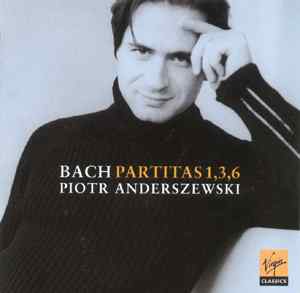 |
|
JS Bach: Keyboard Partitas 1, 3 & 6
Piotr Anderszewski, piano
Virgin Classics 7 24354 55262 5
|
|
0 |
5 |
|
Performance |
 |
|
Sonics |
 |
|
|
Listening to the first notes of Piotr Anderszewski's
new recording of Bach's lovely Partita No.1, one senses a special artist
at work. There's a softness to his touch, a gentleness bordering on
reticence, which makes the beauty of the opening Praeludium linger in the
mind even as the music moves forward to the jaunty pace of the subsequent
Allemande.
Keyboard artist Piotr Anderszewski launched his
international career at the age of 22 when he performed Beethoven's
immensely challenging Diabelli Variations
in London's Wigmore Hall in 1991. A slew of lauded international
appearances and recordings followed, culminating in Anderszewski's receipt
of the 2002 Gilmore Artist Award. The Gilmore Artist Award (billed as
“most generous” financial award granted in the musical arts) is only
presented to exceptional pianists who possess broad and profound
musicianship and charisma, desire and can sustain a major international
concert career, and are considered capable of making “a real impact on
music.”
In acknowledgment for his
many performances throughout the UK, Piotr Anderszewski has been honored
with the 1991 Royal Philharmonic Society's "Best Instrumentalist" Award.
(Previous winners of this prize include such extraordinary artists as
Murray Perahia, Itzhak Perlman, and Andras Schiff). Anderszewski has also
been awarded the prestigious Szymanowski Prize for his interpretation of
that composer's music, and has received support from the Miami-based
Patrons for Exceptional Artists Foundation.
A listen to Anderszewski's three most recent
recordings suggests the depth of musicianship that select U.S. audiences
heard during his March tour. His first Virgin recording, a 2001 traversal
of Beethoven's Diabelli Variations
for solo piano, earned France's Diapason d'Or
and Le Choc Monde de la Musique
awards, and immediately became Gramophone
magazine's recommended recording of this much-recorded opus.
Anderszewski's personal relationship with the work, which the Connecticut
audience will experience first hand on the 25th, has also been captured on
film by noted cinematographer Bruno Monsaingeon.
Anderszewski's second Virgin disc, which spotlights
him playing and conducting Mozart's Piano Concertos Nos. 21 and 24, was
second runner-up for the 2002 Gramophone
Instrumental Award. His latest recording, featuring three of Bach's six
Partitas for solo keyboard, includes the one he will play on his US tour,
Bach's Partita No.1 in B-flat Major, BWV 825.
Because Bach wrote his
Partitas for the harpsichord and/or clavichord, many artists play them on
the modern piano with the limited dynamic range and pin-point sound of its
more modest predecessors in mind. The silvery-toned harpsichord, for
example, has no ability to alter dynamics, while the slight-voiced
clavichord's dynamic and tonal expanse cannot approach the grander reaches
of the modern piano.
There is certainly no hint of the harpsichord in
Anderszewski's Paritas; he unashamedly embraces the concert grand's vast
range of tone and dynamics. In contrast to Glenn Gould, a pianist as famed
for his unbelievably fast, perfectly precise finger work and eccentric (if
not downright wayward) interpretations as for his irrepressible vocal
self-accompaniment, Anderszewski chooses slower tempos. Of the three
Partitas on Anderszewski's disc, Nos.1, 3, and 6, only the opening Toccata
movement of No. 6 is played faster than Gould's version. In No.1, the
lightest and most immediately attractive of the Partitas, Anderszewski's
considerably slower playing comes across as soft and heartfelt where Gould
astounds with percussive accuracy.
Bach's Partita No.1 of 1726, one of his earliest
keyboard “exercises,” is filled with joy and light. As is the case with
all his Partitas, each movement save the opening Praeludium is based on a
dance form. In Anderszewski's hands, the Praeludium is voiced with
extraordinary warmth, Even as the pace increases in the Allemande, the
sweetness of the opening remains. The succeeding Courante is quite inward,
its pace seemingly determined more by the artist's emotional response than
Bach's specific sequence of notes.
The Sarabande, executed at the exceedingly slow pace
of 6:14 (Gould's is 3:08, while a recent recording by the excellent
Vladimir Feltsman is 3:53), transcends the mere mechanics of pianism to
impress as a hallowed act. Then come the two short Minuets, played with a
sense of inevitability that culminates in such sweetness that you would
think that faeries are dancing on the keyboard. All this leads to the
final Gigue, whose beginning is voiced with a touch equally vigorous and
precise. Yet even as Anderszewski reaches the final bars of Bach's
18-minute masterpiece, he again softens, leaving us with the sensitivity
with which he began. It's a marvelous act, sure to delight, and hints of
the revelations awaiting those fortunate enough to have heard him in
person.

|
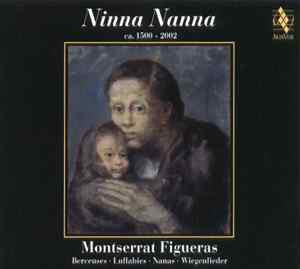 |
|
Ninna Nanna ca. 1500 - 2002
Montserrat Figueras
Alia Vox AV 9826
|
|
0 |
5 |
|
Performance |
 |
|
Sonics |
 |
|
|
Historically informed
interpretations of medieval, Renaissance, and baroque music characterized
by an elevated, almost ethereal sense of refinement have become the
hallmarks of ensemble Hesperion XXI's numerous recordings. Formed in 1974
by conductor and bass viol virtuoso Jordi Savall, Hesperion XXI
(originally called Hesperion XX) is as equally prized for its impeccably
played instrumentals as for its frequent collaborations with Savall's
wife, soprano Montserrat Figueras.
The purity of Figueras'
instrument can be heard on Ninna Nanna (Alia Vox AV9826), a new
18-track disc showcasing her singing six centuries worth of lullabies in
at least ten languages. The disc is accompanied by a thick brochure that
offers translations in eight languages. (Alia Vox, Savall's own label,
must spend a fortune to ship these discs).
To these ears, Figueras'
voice seems most suited to plaintive expression. Produced with minimal
vibrato, the mournful quality of her haunting instrument excels in
conveying the asceticism and sadness frequently expressed in early music.
In selection after
selection, from the anonymous Sephardic cradle song “Nani, nani” composed
ca. 1500 to two contemporary lullabies composed by the Estonian émigré
Arvo Pärt in 2002, Figueras' clarity of enunciation, even vocal
production, and sheer beauty of sound frequently prove seductive.
Selections such as the opening “José Embala o Menino” (Joseph Rocks the
Infant), an anonymous Portuguese lullaby that includes the line “how often
[Mary] is heard to sing when in her heart she weeps,” seem ideal for her
instrument. So too are the anonymous Berbère “Berceuse Amazigh” (“The moon
is very sad…Happiness is with others”), William Byrd's “Come, pretty babe”
(“thy father's shame, thy mother's grief”), and Johann Rriedrich
Reichardt's “Dors mon Enfant” (“Your hapless mother has sorrow enough”).
However, ask Figureras to
perform German composer Max Reger's 1912 “Mariä Wiegenlied,” a romantic
lullaby that depicts the Virgin Mary singing to her infant Jesus, and the
soprano comes up wanting. Lacking the incomparable charm and silvery,
angelic tone that soprano Elisabeth Schumann brought to her magical
recording of the work almost 60 years ago, Figueras' attempts to smile
fail to convince. The lyrics of Reger's little gem may speak of the sweet
scent of roses and sounds of laughter and birds, but one cannot help feel
that Figueras' mournful Virgin Mary is haunted by advance knowledge of her
infant's future crucifixion.
In a spring US tour that
takes Hesperion XXI, Savall and Figueras from Cambridge and New York to La
Jolla and Berkeley by way of Kansas City, the artists will explore the
improvisatory instrumental dance music of 15th and 16th century composers
Ortiz, Sanz, and de Ribayaz. Some of their program can be previewed on
La Folia 1490 - 1701 (Alia Vox 9805), a marvelous recording that
showcases how Savall's highly sophisticated sense of color and space
elevates even the simplest compositions to the level of high art. Figueras'
vocal selections from José Marin's 17th century Tonos Humanos (Alia Vox
9802) will balance out the program. Both discs, as well as two other
Hesperion XXI classics, are slated for April 8 re-release in superior
sounding SACD (Super Audio Compact Disc) format. Music lovers who do not
act fast enough to secure tickets to Hesperion XXI's frequently sold out
programs will find solace in sampling either these discs or some of the
other 100 or so recordings that feature Savall and assorted ensembles.

|
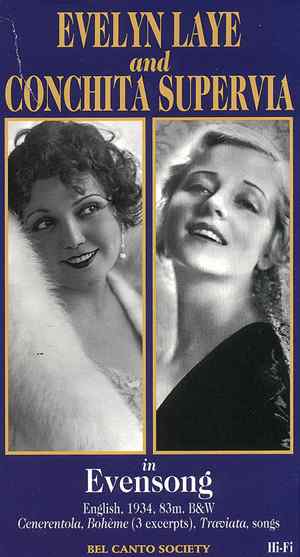 |
|
Evelyn Lane
and Conchita Supervia in Evensong
Bel Canto Society VHS BCS-0526
(available from
http://www.allegro-music.com)
|
|
0 |
5 |
|
Performance |
 |
|
Sonics |
 |
|
|
Why does this VHS of an obscure, 83 minute, 1934 B&W
movie deserve your attention? For one major reason: it affords us our only
opportunity to see rare footage of the astounding Spanish mezzo-coloratura
Conchita Supervia.
Born in Barcelona on December 9, 1895, Conchita
Supervia made her début at the Colón Opera House in Buenos Aires at the
age of 15. A year later, she created the role of Octavian in the Rome
premiere of Richard Strauss' Der Rosenkavalier.
So astounding was her artistry that
within another year she was playing the mature roles of Carmen and Dalila.
Treasured most for her extraordinary way with Rossini
and Spanish song, Supervia was so revered for her vocal intensity and
infectious joie de vivre that
once, in a rehearsal for the scene in Rossini's La Cenerentola
where Cinderella is driven to the ball by stagecoach, conductor Sir Thomas
Beecham ran onstage, threw himself before her, and offered to play the
horse.
This is not to say that Supervia's voice and prima
donna will were not controversial. Possessed of a strong, prominent
vibrato, wickedly characterized as a rattle by the New York record
salesman I encountered over 30 years ago, hers was an amazing sound that
continues to astound. Deep on bottom, free on top, and strong throughout,
the voice was expressed with a thrust and verve that resound of
Spanish/gypsy roots. The only modern mezzo who approaches Supervia in
imagination and vitality, if not in vocal color, is Cecilia Bartoli.
Married to a brilliant intellect, Supervia's voice
was employed with utmost skill, alternately growling, purring, seducing,
pouting, pleading, and taunting. Performing in an era when no one would
bat an eyelash when she and a fellow Spanish soprano recorded German duets
from Der Rosenkavalier in Italian,
the mezzo knew little of “correct” Mozart style or historically-informed
embellishments. Instead, she bent tempo and phrasing to her will, speeding
up and slowing down as would a large cat stalking its prey. The results
are irresistible.
Supervia made well over 100 recordings before dying
in 1936, at the height of her fame, from complications during childbirth.
Many of her discs, such as her hilarious rendition of Sharp's “Oh no,
John,” sung with an unforgettable cockney accent tinged with Spanish
roots, and her set of Gennai's four Canzioncine, charming children's songs
written for her which feature spoken introductions and animal sounds
(Pearl GEM 0184), have long been considered collector's items. Supervia
was also the most passionate Carmen of her time, and equal to Elisabeth
Schumann in the wealth of expression she brought to her few recordings of
Mozart.
Back to Evensong.
Supervia appears all to briefly toward
the end of the film, playing an aging soprano's rival in a staged
production of Puccini's La Bohème.
Dressed to the hilt, and sporting a
larger than life bonnet, the mezzo sings “Musetta's Waltz” while
delightfully dancing about, flirting with her male admirers, and batting
her fan in their faces. Her physical beauty is complemented by such a
wealth of exaggerated vocal and physical expression as to suggest none
other than an operatic Carmen Miranda.
Supervia also sings bits of three Spanish songs,
including Valderde's “Clavelitos” which she recorded at least twice (GEM
0184 and GEMM CD 9975). While she's drowned out by Evelyn Lane's prima
donna tirades, what we can hear makes us long for more.
What about the rest of the film? British musical star
Evelyn Lane looks wonderful, sings quite well, and becomes more convincing
as the hackneyed plot gradually affords her opportunities to act real.
Australian tenor Browning Mummery and German actor Kortner (who starred in
Pabst's Pandora's Box) also make
welcome appearances. But the story, loosely based on the ascent and
descent of Australian soprano Nellie Melba, is one of those predictable
jobs best seen late at night while chewing lots of popcorn. It's a period
piece to be sure, but Supervia's cameos, which by themselves rate a 5, are
timeless.

|
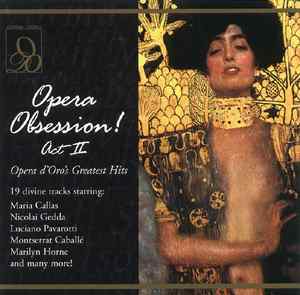 |
|
Opera Obsession! Act II
Opera d'Oro's Greatest Hits
OPD 1002
|
|
0 |
5 |
|
Performance |
 |
|
Sonics |
 |
|
|
Less than a year ago, I enthusiastically endorsed
Opera d'Oro's “Act I” Opera Obsession!
compilation of mostly live operatic arias and scenes. Drawn from the
label's extensive catalogue of complete operatic performances, the
sampler's $2.99 list price for over 78 minutes worth of music makes
pondering purchase a no-brainer.
As might be expected, selections sung by the biggest
names provide the raison d'etre to part with such a huge sum in tough
times. Tenor Luciano Pavarotti begins the proceedings as Rodolfo in
Puccini's La Bohème, singing the
duet “O Mimì, tu più non torni” with Sesto Bruscantini. In this 1969 Rome
performance conducted by the late Thomas Schippers, Pavarotti's beauty of
tone, ardour, and intelligent phrasing -- the latter not always a given,
especially later in his career - combined with excellent sound and a
self-recommending Mimi from the young Mirella Freni, whet the appetite for
the complete recording ($11.98 list). Pavarotti also scores big time in a
1970 Rome “Ingemisco” from Verdi's Requiem,
his fellow singers Scotto, Horne, and Ghiaurov, conducted by Claudio
Abbado, making purchase equally tempting.
Shirley Verrett's appearance does not convince that
she was the greatest Carmen of the
last century, but her 1973 “Près des ramparts de Seville” duet with
Placido Domingo, conducted by Sir Georg Solti, finds the second of our
“Three Tenors” in most heart-igniting voice. Nor are he and Pavarotti
alone in this regard. Yet another tenor, Richard Tucker, does not usually
impress as the most subtle or beautifully voiced of artists, but his
“Rachel, quand du Seigneur” from a 1973 La Juive
elicits such a strong sense of personal identification from this former
Cantor as to render it the most convincing performance of Halévy's aria I
have ever encountered.
Opera d'Oro's catalogue is thankfully blessed with at
least five live opera performances by the incomparable soprano, Montserrat
Caballé. In one of two excerpts provided herein, the diva blows the socks
off Cilea's “Io son l'umile ancella” from Adriana Lecouvreur,
choosing to extend the final word of text rather than, as did the role's
creator Magda Olivero, make a drama and a half of her penultimate
utterance. (Caballé's co-star, whom we don't hear on this compilation, is
none other than Domingo).
Caballé returns in a less than ideally recorded 1968
broadcast of Puccini's Madama Butterfly,
singing the beloved “Un bel di, vedremo.” In her first vocal bloom, her
occasional idiosyncracies amount to nothing when heard aside such
gorgeously spun pianissimos and strong climactic phrases. This is a great
performance.
For me, the big discovery of this set is the tenor of
Alexander Oliver in Massenet's rarely heard “ah, qu'il est loin, mon pays”
from Sappho. Oliver may not have
the strongest top, but his tone is so warm and healthy at the start of the
opera as to make me want to hear much more of him.
Opera d'Oro inexplicably omits Maria Callas' name
from the cover, but her famed 1955 live “Casta diva” from Bellini's
Norma is gorgeously and securely
sung. If I am less won over by the contributions of Margherita Rinaldi and
Peter Schreier, and the selections afforded Marilyn Horne and Nicolai
Gedda, I still find so much of value in this compilation, combined with
some fine mastering on the better-captured performances, as to welcome
this disc with open arms.

|
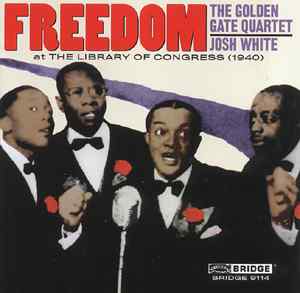 |
|
Freedom: The Golden Gate Quartet & Josh White at the Library of
Congress (1940)
Bridge 9114
|
|
0 |
5 |
|
Performance |
 |
|
Sonics |
 |
|
|
Winner of the Indie Award for Best Historical
Recording of the Year, the musical and social impact of this
never-before-released performance cannot be overstated. “A Program of
Negro Folk Song with Commentary,” presented at the Library of Congress on
December 20, 1940 as part of a four-day festival celebrating the 75th
anniversary of the passage of the thirteenth amendment to the U.S.
Constitution, the concert stands as an example of America's double
standard: a country that sponsored a celebration of slavery's abolition in
a racially segregated city, and feted artists who were otherwise not
allowed to sit in the front of the bus.
It was certainly a departure to present this program
in an austere government venue that traditionally hosted classical
concerts. (Only the year before, the Daughters of the American Revolution
had banned contralto Marian Anderson from performing in D.C.'s
Constitution Hall, resulting in Eleanor Roosevelt's resignation from the
DAR and Anderson's triumphant performance on the steps of the Lincoln
Memorial). Equally striking were spoken commentaries interjected between
selections by Dr. Sterling Brown, a poet who delivered his message with
the authority of an elder statesman; Dr. Alain Locke, godfather to the
Harlem Renaissance; and Alan Lomax, famed folk researcher and archivist.
The masterfully sung concert, presented intact, was
performed in three parts. The first, consisting of six Negro spirituals,
began with a stirring rendition of “Freedom,” a song oft repeated during
the civil rights movement of the 1960's. The second part featured five
blues and ballads, interspersed with striking “What are the Blues” and
“The Social Song” commentary by Sterling Brown. The last part, five reels
and work songs, included such classics as “Old Dan Tucker” and ”Rock My
Soul in the Bosom of Abraham.”
The impeccably voiced Golden Gate Quartet was founded
in 1930 when four male students at Norfolk, Virginia's all-black Booker T.
Washington High School began harmonizing in a barbershop. Originally
specializing in Negro Spirituals, the quartet late branched out to include
gospel music. By the time they reached the Library of Congress, their
creamy, velvety sound had generated a Victor Bluebird recording contract,
a performance in Carnegie Hall, and regular nationwide CBS live broadcasts
from New York.
Josh White (1915-1969) began his singing career as a
companion and guide to a group of blind gospel and blues performers. By
1940, he had become one of the most respected solo performers in his
field; recorded numerous Christian/Gospel songs, blues, and folk numbers;
and shared the stage with “Ole Man River” bass and freedom fighter Paul
Robeson in the show John Henry.
In our time of increased racial division and unjust
deportation of middle easterners, Sterling Brown's chilling account of how
the great blues singer Bessie Smith died because she could not gain
admittance to a white hospital gains new meaning. Equally telling are his
description of the blues as “the poor man's heart disease” and the
“Negro's song of frustration,” the nervous laughter accompanying his
commentary, and Josh White's moving rendition of “Silicosis Blues.”

|
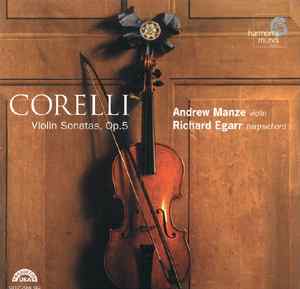 |
|
Corelli: Violin Sonatas, Op. 5
Andrew Manze, violin; Richard Egarr, harpsichord
Harmonia Mundi HMU 907298.299 (2 discs)
|
|
0 |
5 |
|
Performance |
 |
|
Sonics |
 |
|
Just as the “high baroque” style of composition was
approaching its peak, 47-year old Italian composer, teacher, and violinist
Arcangelo Corelli published his set of twelve violin sonatas. The
auspicious date was January 1, 1700. If Corelli's successors, who included
his students Geminiani and Vivaldi as well as Bach and Handel, took the
baroque style of melodic, highly ornamented composition one step farther,
it was in no small part because they had as their foundation Corelli's
pivotal violin sonatas. Indeed, as violinist Andrew Manze postulates in
his highly articulate liner notes, in the same way lovers of bel canto
opera date 20th century performance style as “Before Callas”
(BC) and “After Callas” (AC), so too can baroque sonatas be defined as
pre- or post-Corelli.
This is gorgeous music, filled with carefully
balanced harmonic invention and a weight of contemplation that deepens its
beauty. What we hear, however, is considerably different than what Corelli
originally set down in print. The first published score of Corelli's
sonatas only hints at what he and other 18th century virtuosos
made of his music.
The ultimate effect of baroque performance hinged
upon spontaneous embellishment, a free, improvisational approach to the
printed score similar to the way a jazz musician might approach a classic
song by Irving Berlin or Harold Arlen. Improvisation and embellishment are
exactly what Corelli and other baroque composers expected of performers.
Rarely did they write out ornamentation; when they did, it was intended
more as a model than as a blueprint to be slavishly copied.
In Corelli's case, a second edition of his sonatas,
published in Amsterdam in 1710 by Estienne Roger, claims to contain the
exact copious ornamentation that Corelli used when he played the twelve
slow movements of his sonatas. Rather than copying Corelli's ornamentation
and treating the music as a museum piece, Andew Manze and Richard Egarr
bring the sonatas to life by calling upon their own improvisatory skills
and vast knowledge of baroque practice to create new versions.
Manze and Egarr are recognized masters of the baroque
form. With a discography that includes Bach's Harpsichord Concertos and
Violin Sonatas by Bach and Rebel, their set of Handel's complete Violin
Sonatas received a Grammy nomination, Gramophone
Editor's Choice and was called ‘the finest recording of Handel's violin
sonatas ever made” by International Record Review,
while their single disc of Pandolfi's CompleteViolin Sonatas received both
the prestigious 2000 Gramophone Award and a Choc du Monde de la Musique.
Their revelatory interpretations are a far cry from the deadly St. Martins
in the Fields versions that dominated the early music catalogue of an
earlier generation.

|
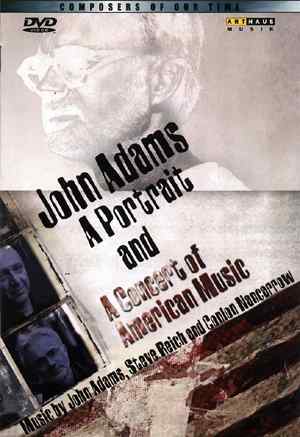 |
|
John Adams: A Portrait and A Concert of American Music
DVD-Video
Arthaus Musik PAL 100 323
|
|
0 |
5 |
|
Performance |
 |
|
Sonics |
 |
|
Composer portraits abound these days, and for good
reason. A video biography accompanied by shots of composer, collaborators,
and performers in action potentially allows deeper access to a composer's
inner world than that afforded by sound alone. A case in point is this
portrait of the affable Adams. Offering a 52-minute portrait in Dolby
digital 2.0 sound and an 82-minute concert of American music in Dolby
Digital 5.0 and DTS 5.0 surround sound, it can well serve as an
introduction to the minimalist style of late 20th century
composition.
Long-time Berkeley resident John Adams has long been
considered one of the moving forces in contemporary composition.
Originally assessed as a member of the same minimalist camp as Steve Reich
and Philip Glass, his writing has consistently evolved to include greater
melodic inspiration. Equally important has been his desire, manifested in
such operas as Nixon in China and
Death of Klinghofer, to
join the lead of Mozart, Verdi and others in exploring the social and
political fabric of contemporary society.
The composer portrait, narrated by Amita Dhiri, moves
from an introduction to Adams' universe to an exploration of his childhood
and studies at Harvard. A segment that explores influences on Adams' music
segues into chapters devoted to the oratorio El Nino
and the operas Nixon in China,
and Death of Klinghofer.
The wonderful El Nino
segments, taken from the recently released the 2002 Gramophone Award
winning DVD of the oratorio (ArtHaus Musik 100 220), feature Dawn Upshaw,
Lorraine Hunt Lieberson, and Willard White.
Accompanied by the Maîtrise de
Paris Children's Choir, London Voices, Theatre of Voices, and Deutsches
Symphony Orchestra, Berlin conducted by Kent Nagano, the segments include
a marvelous scene with Hunt Lieberson and animated interview with the
brilliant director Peter Sellars. Of special interest are the surprised
reactions of Adams and his collaborators to the huge amount of controversy
that Klinghofer stirred up
within segments of the Jewish community. Though the musical interludes may
be brief, they also afford an opportunity to explore Adams' evolution as a
composer of distinction.
The Concert of Modern American Music, featuring the
Ensemble Intercontemporain conducted by Jonathan Nott, is a curious
affair. As wonderful as the four selections may be -- Steve Reich's
Eight lines (also available in two
different audio CD versions),
John Adams' Gnarly buttons 2 for clarinet and ensemble
(available in two audio recordings, one
featuring the Ensemble Intercontemporain conducted by David Robertson),
Adams' Chamber Symphony
(available in three different audio performances), and the first and
seventh of Conlon Nancarrow's extraordinary Studies for Player
Piano (usually heard in piano
version - be sure to check out Conlon Nancarrow : Lost Works,
Last Works (OM 1002-2) available from http://www.otherminds.org)
- the absence of Adams as conductor seems most unfortunate. Be that as it
may, the Ensemble plays with noted authority, and Nott conducts with
delightful fluidity. Personally, I would rather hear this music better
reproduced on good two-channel recordings than watch infinite shots of
conductor, ensemble and soloists, but the benefits of surround sound will
more than compensate for those willing to shut their eyes.
- Jason Serinus
-
Terms and Conditions of Use

|